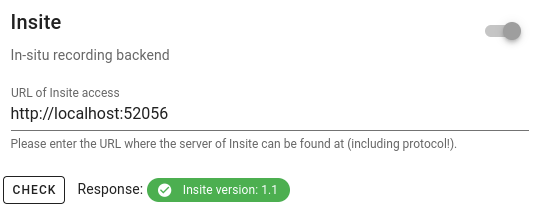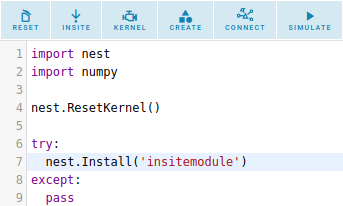Simulate with Insite¶

This is a guide to show how to use NEST Desktop with Insite.
Insite is a recording backend module which is also usable with NEST Simulator. Basically, with Insite, neuronal or network activity can be observed during the simulation.
Note
Simulations with Insite need to be run with the Insite docker images nest-module and access-node. The best method is to use Docker Compose, which also deploys NEST Desktop and Insite. For more information, please read the deployment guide of Insite.
Check if Insite is running¶

In the settings page you can check whether the Insite backend is running. When it is disabled, you can toggle the slide to enable it.
Enable simulation with Insite¶

After successfully receiving a ping from the Insite access node of the backend, you can activate the button Insite (second from left) in the toolbar of the code editor. Then, NEST Desktop generates the script such that Insite is used during the simulation.
Script code for simulation with Insite¶
The Insite module has to be loaded into the NEST kernel. Preferentially load the insitemodule after importing NEST:
nest.Install('insitemodule')
Next, check wether the parameter record_to of any recording device (e.g. spike recorder, multimeter or
voltmeter) has to be modified:
...
recorder.set({"record_to": "insite"})
...
Now, the Insite recording module collects activity events from the recording devices in the NEST Simulator. NEST Desktop
receives activity from the Insite access node on another port (default: 52056).
See also
For more information about Insite, please visit the official documentation of Insite from the VR Group of RWTH Aachen.
Acknowledgements¶
Thanks for integrating Insite in NEST Simulator and NEST Desktop:
- Simon Oehrl (Conceptual design for Insitufication in NEST Desktop)
- Marcel Krüger (Collaboration on Insitufication in NEST Desktop)